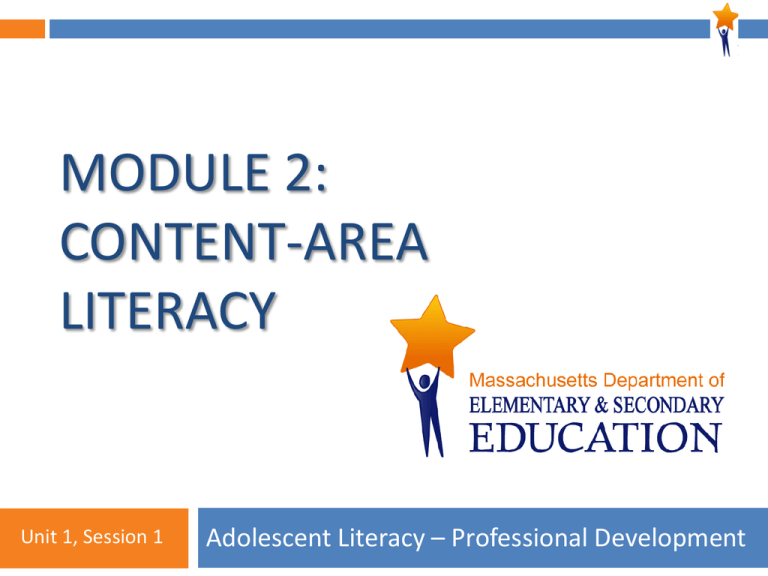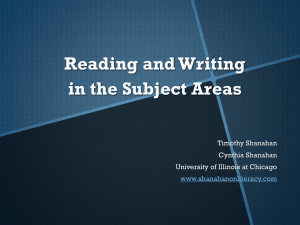Module%202_Unit%201_Session%201_V1
advertisement

MODULE 2: CONTENT-AREA LITERACY 2: Unit 1 1, Session 1 Unit Module 1, Session Adolescent Literacy – Professional Development WHAT DOES IT MEAN TO TEACH “DISCIPLINE-SPECIFIC” LITERACY SKILLS? An Introduction for Middle & High School Content-Area Teachers Module 2: Unit 1, Session 1 Essential Questions Module 2 Question What role can content-area teachers play in helping adolescents acquire general and discipline-specific literacy skills? Unit 1, Session 1 Questions How is “disciplinary literacy” different from “teaching reading”? What does “disciplinary literacy” mean in terms of content-area instruction? How can we further content-area goals by thinking about “disciplinary literacy”? Module 2: Unit 1, Session 1 3 Warm Up Read an excerpt from Shanahan & Shanahan’s article “Teaching Disciplinary Literacy” Text-Rendering What might “teaching disciplinary literacy” look like in your school? What might this look like in the future? Module 2: Unit 1, Session 1 4 Moving Beyond “Every Teacher Is a Teacher of Reading” Disciplinary What do these three stages of literacy instruction mean for us? Intermediate Literacy Basic Literacy Adapted from Shanahan & Shanahan, 2008, p. 44. Module 2: Unit 1, Session 1 5 What Does “Basic Literacy” Mean? Skills such as decoding and recognizing sight words These are literacy skills acquired by most students in the earliest grades Basic Literacy These skills are the necessary building-blocks for more advanced, specialized reading skills Adapted from Shanahan & Shanahan, 2008, p. 44. Module 2: Unit 1, Session 1 6 “Basic Literacy” in Secondary School? Most middle and high school students will have acquired these basic skills The small number of students who need help with decoding/phonological skills may need to see a reading specialist for remedial help Basic Literacy Content-area teachers might note gaps in basic skills, but most likely will not “teach” basic skills regularly Adapted from Shanahan & Shanahan, 2008, p. 44. Module 2: Unit 1, Session 1 7 What Does “Intermediate Literacy” Mean? These are more complex skills that are common across most reading tasks Intermediate Literacy Comprehension, making inferences, knowing common word meanings, basic fluency Strategies for improving these common skills might be shared by all content-area teachers Adapted from Shanahan & Shanahan, 2008, p. 44. Module 2: Unit 1, Session 1 8 “Intermediate Literacy” in Secondary School? Middle and high school students are primed to learn common reading strategies that can be applied across many contexts Intermediate General comprehension strategies (e.g., questioning while reading, note-taking, predicting, summarizing, etc.) Literacy These are the skills and strategies that then can be tailored to each discipline Adapted from Shanahan & Shanahan, 2008, p. 44. Module 2: Unit 1, Session 1 9 What Does “Disciplinary Literacy” Mean? Disciplinary Literacy These are the highly-specialized skills needed to read, interpret, synthesize, etc. within each discipline These are the skills that experts within each discipline rely upon to understand and communicate knowledge These skills build on general/common skills and strategies, but are more narrowly tailored Adapted from Shanahan & Shanahan, 2008, p. 44. Module 2: Unit 1, Session 1 10 “Disciplinary Literacy” in Secondary School? Disciplinary Middle and high school students are ready to begin learning discipline-specific reading skills/strategies Literacy The goal is to teach content more effectively by adapting general reading skills/strategies to subject-specific tasks General comprehension strategies (e.g., questioning, note-taking, predicting, summarizing, etc.) can be tailored by each content-area teacher Adapted from Shanahan & Shanahan, 2008, p. 44. Module 2: Unit 1, Session 1 11 Tailoring a Strategy How might we share the teaching of an intermediate skill/strategy, such as “summarizing,” across content areas? How might we tailor “summarizing” to meet particular disciplinary goals? Let’s look at (and then begin to adapt) a simple summarization strategy from Adlit.org Module 2: Unit 1, Session 1 12 Wrap-Up Things to Remember: Content-area teachers are not “reading teachers” per se. The focus is on teaching CONTENT while being aware of discipline-specific literacy skills. Students will need to understand scientific notation, mathematical symbols, primary documents, timelines, figures/graphs, poems, etc. Module 2: Unit 1, Session 1 13 References Jacobs, V. A. (2008). Adolescent literacy: Putting the crisis in context. Harvard Educational Review, 78(1), 7–39. Moje, E. B. (2008). Foregrounding the disciplines in secondary literacy teaching and learning: A call for change. Journal of Adolescent & Adult Literacy, 52(2), 96–107. Shanahan, T., & Shanahan, C. (2008). Teaching disciplinary literacy to adolescents: Rethinking content-area literacy. Harvard Educational Review, 78(1), 40–59. Module 2: Unit 1, Session 1 14






